Block or unblock senders in Outlook
You can block messages from specific email addresses or domains from reaching your inbox. When you add an email address or domain to your blocked senders list, Outlook automatically moves messages from that sender to the Junk Email folder.
Note: You can have up to 10,000 addresses or domains in the blocked senders and safe senders lists. If you want to add more than that, try blocking domains instead of individual email addresses.
Select a tab option below for the version of Outlook you're using. What version of Outlook do I have?
Note: If the steps under this New Outlook tab don't work, you may not be using new Outlook for Windows yet. Select the Classic Outlook tab and follow those steps instead.
Block senders from sending you email in new Outlook for Windows
If you're receiving unwanted email, you can block the email addresses and domains you don't want to receive messages from. Add any email address or domain to your blocked senders list to move these messages directly to your Junk Email folder.
Note: Email is automatically removed from the Junk Email folder after 14 days and can't be recovered after that. For more information, see Recover deleted email messages in Outlook on the web.
-
If you have more than one account added to new Outlook, select the account you want to add the settings to.
-
Select Settings > Mail > Junk email.
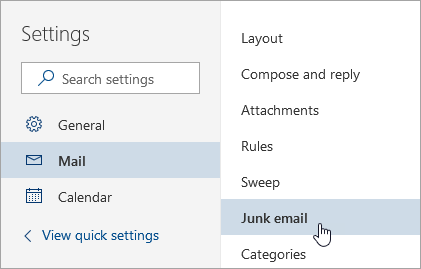
-
If you want to block an email address, enter the email address in Blocked senders and select Add. If you want to block all email from a domain, enter the domain name in Blocked domains and select Add.

-
Select Save.
Unblock senders
If you want to remove someone from the blocked senders list, follow the instructions below.
-
Select Settings > Mail > Junk email.

-
Select the address or domain you want to unblock and select

Stop messages from going into your Junk Email folder
There are times when you don't want messages from a specific person or domain to end up in your Junk Email folder.
Messages from addresses or domains on the safe senders list won't get moved to your Junk Email folder.
-
Select Settings > Mail > Junk email.

-
Under Safe senders, enter the email address or domain you want to add, and select Add.
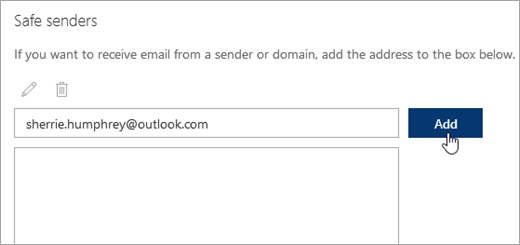
-
Select Save.
Tips:
-
To edit or remove email addresses or domains from the blocked senders or safe senders list, select the item in the list and then select


-
To empty your Junk Email folder, select Junk Email in the left pane. At the top of the screen, select Delete all.
Block a sender in classic Outlook for Windows
When you no longer want to see messages from someone, you can block a sender.
-
Right-click a message from the sender you want to block, and then click Junk > Block Sender.
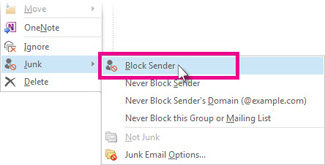
The blocked person can still send you mail, but if anything from his or her email address makes it to your email account, it’s immediately moved to the Junk Email folder. Future messages from this sender will go to your Junk Email folder or End-User Quarantineif enabled by your administrator.
It’s a good idea to periodically review email messages identified as junk to make sure you’re not missing important messages.
If you later decide you want to unblock a sender, use Junk Email Filters to change which messages you see.
Messages from addresses or domain names in the Blocked Senders List are always treated as junk. Outlook moves any detected incoming message from senders in the Blocked Senders List to the Junk E-mail folder, regardless of the content of the message.
Note: The Outlook Junk Email Filter doesn’t stop junk email from being delivered, but instead diverts suspected spam to the Junk E-mail folder instead of your inbox. You can make the Junk Email Filter more strict by changing its level of protection, or some third-party solutions are available which can be more aggressive.
To add a specific sender to the Blocked Senders List, click a message from the sender. On the Home tab, in the Delete group, click Junk and then click Block Sender.
To add names to the Blocked Senders List:
-
On the Home tab, in the Delete group, click Junk, and then click Junk E-mail Options.
-
On the Blocked Senders tab, click Add.
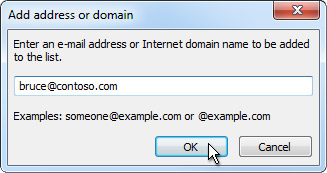
-
In the Enter an e-mail address or Internet domain name to be added to the list box, enter the name or address that you want to add. For example, you can add :
-
a specific email address, such as someone@example.com
-
an Internet domain, such as @example.com, or example.com.
-
-
Click OK and repeat for each entry that you want to add.
Notes:
-
If you have existing lists of safe names and addresses, you can move that information into Outlook. Click Import from File and browse for the list file that you want. To create a file that uses your current list, click Export to File and then specify where you want the new file saved.
-
To change a name on the list, click the name that you want to change and then click Edit. To remove a name, click the name that you want and then click Remove.
-
If you are using a Microsoft Exchange account, all of the names and email addresses that are in your organization's address book — also known as the Global Address List — are automatically considered safe and can’t be added to the blocked list.
-
By adding email addresses and domain names that you trust to the Safe Senders List, you instruct Outlook that messages from those sources are never to be considered as junk. If you belong to mailing lists or distribution lists, you can add these names to your Safe Recipients List.
Note: If your mailbox is hosted on Exchange or Exchange Online, changes you make to the Safe Senders list will not be recognized by Exchange or Exchange Online. This may result in messages from domains or senders you've added to the Safe Senders list ending up in your Junk Email folder. Contact your administrator for further assistance.
To add a person to the Safe Senders List, click a message from the sender. On the Home tab, in the Delete group, click Junk, and then click Never Block Sender.
To add a specific address or domain to the Safe Recipients List, click a message from the sender. On the Home tab, in the Delete group, click Junk, and then click Never Block the Group or Mailing List.
To manually add names or domains to these lists, do the following:
-
On the Home tab, in the Delete group, click Junk, and then click Junk E-mail Options.
-
Do one of the following:
-
To add safe senders, on the Safe Senders tab, click Add.
-
To add safe recipients, on the Safe Recipients tab, click Add.

-
-
In the Enter an e-mail address or Internet domain name to be added to the list box, enter the name or address that you want to add. For example, you can add :
-
a specific email address, such as someone@example.com
-
an Internet domain, such as @example.com, or example.com.
-
-
Click OK and repeat for each entry that you want to add.
-
If you want all Contacts to be considered safe senders, select the Also trust e-mail from my Contacts check box in the Safe Senders tab.
-
Some people whom you correspond to might not be listed in your Contacts. If you want all such people to be considered as safe senders, select the Automatically add people I e-mail to the Safe Senders List check box.
-
If you have existing lists of safe names and addresses, you can move that information into Outlook. Click Import from File and browse for the list file that you want. To create a file that uses your current list, click Export to File and then specify where you want the new file saved.
-
To change a name on either list, click the name that you want to change and then click Edit. To remove a name, click the name that you want and then click Remove.
-
If you are using a Microsoft Exchange Server account, all of the names and email addresses that are in your organization's address book — also known as the Global Address List — are automatically considered safe.
-
You may find unwanted email messages come from particular countries/regions. Outlook lets you block messages from those areas - the Blocked Top-Level Domains List lets you block messages from email addresses that end in a particular top-level domain or country/region code. For example, selecting the CA [Canada], US [United States], and MX [Mexico] check boxes in the list blocks messages that come from email addresses that end in ca, us or mx. Additional country/region codes appear in the list.
-
On the Home tab, in the Delete group, click Junk, and then click Junk E-mail Options.
-
On the International tab, click Blocked Top-Level Domain List.
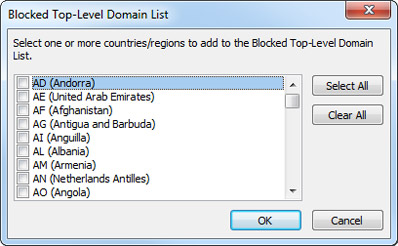
-
In the list, select the check box for the country/region code that you want to block, or click Select All.
-
Click OK in both open dialog boxes..
You can block all email addresses in language encodings — also known as character sets, or alphabets — that you specify. Today, most junk email is sent in the US-ASCII encoding. The remainder is sent in various international encodings. By using the Blocked Encodings List, you can filter out unwanted email messages that are displayed in languages that you don't understand.
-
On the Home tab, in the Delete group, click the arrow next to Junk, and then click Junk E-mail Options.
-
On the International tab, click Blocked Encodings List.
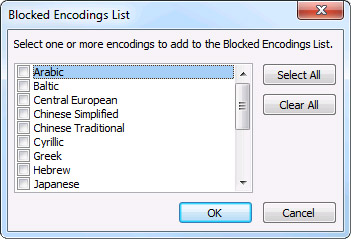
-
In the list, click the language encoding that you want to block, or click Select All.
-
Click OK in both open dialog boxes
Notes:
-
Unicode encodings aren’t included in the Blocked Encodings List.
-
Messages that have unknown or unspecified encodings are subject to filtering by the regular Junk Email Filter.
-
Related Topics
Mark email as junk or block senders in Outlook.com
Filter junk email and spam in Outlook on the web
Block senders from sending you email in new Outlook for Windows
If you're receiving unwanted email in the web version of Outlook, you can block the email addresses and domains you don't want to receive messages from. Add any email address or domain to your blocked senders list to move these messages directly to your Junk Email folder.
Note: Email is automatically removed from the Junk Email folder after 14 days and can't be recovered after that. For more information, see Recover deleted email messages in Outlook on the web.
-
If you have more than one account added to new Outlook, select the account you want to add the settings to.
-
Select Settings > Mail > Junk email.

-
If you want to block an email address, enter the email address in Blocked senders and select Add. If you want to block all email from a domain, enter the domain name in Blocked domains and select Add.

-
Select Save.
Unblock senders
If you want to remove someone from the blocked senders list, follow the instructions below.
-
Select Settings > Mail > Junk email.

-
Select the address or domain you want to unblock and select

Stop messages from going into your Junk Email folder
There are times when you don't want messages from a specific person or domain to end up in your Junk Email folder.
Messages from addresses or domains on the safe senders list won't get moved to your Junk Email folder.
-
Select Settings > Mail > Junk email.

-
Under Safe senders, enter the email address or domain you want to add, and select Add.

-
Select Save.
Tips:
-
To edit or remove email addresses or domains from the blocked senders or safe senders list, select the item in the list and then select


-
To empty your Junk Email folder, select Junk Email in the left pane. At the top of the screen, select Delete all.










